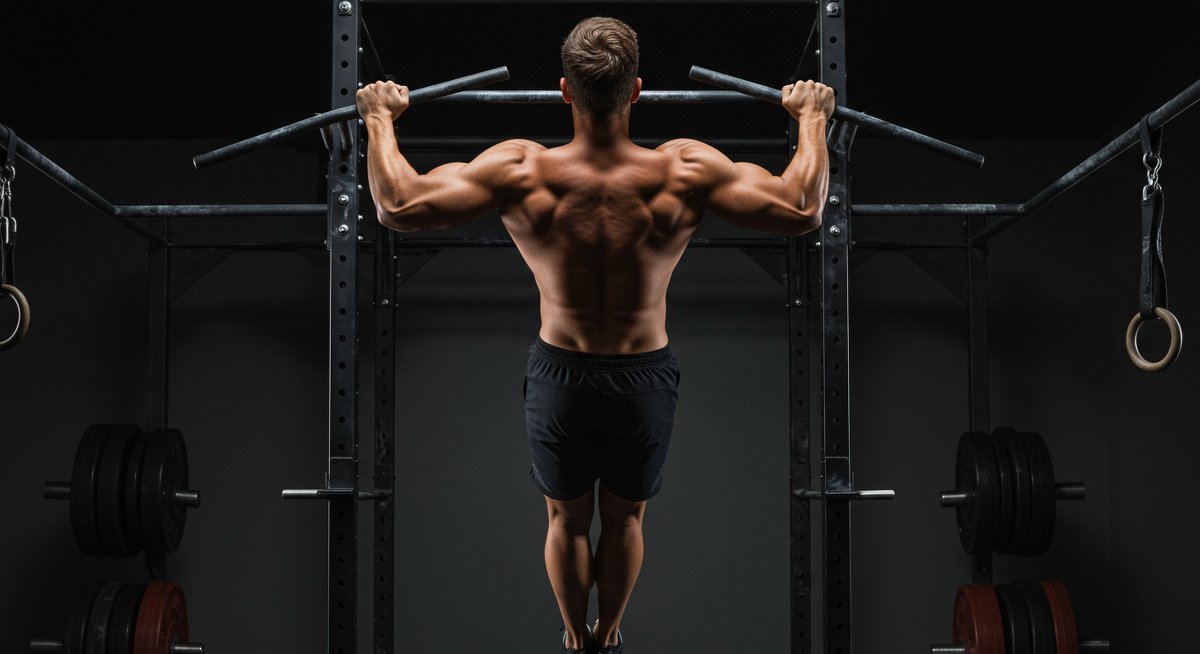Why This Reddit Post Got Me Thinking
So, I was browsing r/bodyweightfitness the other day, and a post caught my eye. Someone was asking if underhand chin-ups are actually better for targeting the lats than wide-grip pull-ups. Apparently, they'd always been told that wide grip was the way to go, but then they stumbled upon some info from Dorian Yates suggesting otherwise. This got me thinking – how many people are missing out on potential lat growth because of this common misconception?

It's one of those fitness myths that seems to stick around forever. You see people at the gym cranking out wide-grip pull-ups, convinced they're sculpting the ultimate back. But what if they're not actually hitting their lats as effectively as they could be? What if a simple change in grip could unlock a whole new level of back development? That's what we're going to break down. We'll look at what Dorian Yates had to say, examine the biomechanics of different grips, and figure out how you can apply this knowledge to your own training. It's time to question what we think we know and get serious about building those lats.
Decoding the Chin-Up vs. Pull-Up Debate
The Reddit poster mentioned that Dorian Yates, a legendary bodybuilder, suggested that underhand chin-ups actually hit the lats more effectively than wide-grip pull-ups. Yates even recommended visualizing the pulling motion to feel the difference. He said chin-ups felt like a pure lat exercise, while wide-grip pull-ups engaged the upper back more. This lines up with what I've experienced and what I've seen in others over years of training. It's not that wide-grip pull-ups are bad, it's just that they might not be optimal for lat growth.
Here's the thing: wide-grip pull-ups definitely work your back, but they tend to recruit the smaller muscles of the upper back, like the teres major and minor, rhomboids, and upper traps. When you feel those muscles working, it can feel like you're building width, but you might just be working the wrong muscles. The lats originate under the armpits and insert near the waist, so you need a movement that allows for a full range of motion and a strong contraction in that area. A narrower, underhand grip allows for that better stretch and contraction.
Think about it this way: the lats are responsible for adduction (bringing your arms towards your body) and extension (bringing your arms down from overhead). A close-grip, underhand position allows for a greater range of motion in both of those movements. Plus, it puts your biceps in a stronger position. Your biceps assist in the pull-up motion, but they shouldn't be the limiting factor. With a wide grip, the biceps can fatigue before your lats are fully stimulated, which means you're leaving potential growth on the table.
What This Means for Your Back Workouts
So, what does all this mean for you? Should you ditch wide-grip pull-ups altogether? Not necessarily. But it probably means you should prioritize chin-ups and other close-grip variations in your back workouts. If you're someone who's been struggling to see lat development despite doing pull-ups for years, this could be the missing piece of the puzzle.
Instead of focusing solely on wide-grip pull-ups, try incorporating more chin-ups into your routine. You can also experiment with different close-grip variations, like neutral-grip pull-ups (using a parallel grip) or even using a V-bar attachment on a lat pulldown machine. The key is to find a grip that allows you to feel a strong contraction in your lats and a full range of motion. I've personally found that varying my grip throughout my training cycle helps keep things fresh and ensures I'm hitting my lats from different angles. I'll often start with a set of wide-grip pull-ups to warm up my upper back, then move into chin-ups or close-grip pulldowns for the majority of my workout.
Another thing to consider is your form. It's easy to let your form break down as you get tired, especially with pull-ups. Focus on maintaining a controlled movement throughout the entire range of motion. Avoid kipping or using momentum to swing yourself up. This not only reduces the effectiveness of the exercise but also increases your risk of injury. Think about pulling with your elbows, not just your hands. This will help you engage your lats more effectively.
I see a lot of people make the mistake of rushing through their reps or not fully extending at the bottom of the movement. Make sure you're getting a full stretch in your lats at the bottom and squeezing them hard at the top. It's better to do fewer reps with good form than a bunch of sloppy reps that don't really target the muscles you're trying to work.
The Truth About Back Training That No One Admits
Here's a reality check: building a strong, wide back takes time and consistency. There's no magic exercise or secret technique that will transform your back overnight. It's about putting in the work week after week, month after month. And it's also about understanding your own body and finding what works best for you. What works for Dorian Yates might not work for you, and that's okay. The key is to experiment, pay attention to how your body responds, and adjust your training accordingly.
One of the biggest challenges people face when trying to build their back is consistency. It's easy to skip back day or phone it in when you're feeling tired or unmotivated. But if you want to see results, you need to make back training a priority. Find a training split that works for you and stick to it. Schedule your workouts in advance and treat them like appointments you can't miss. I've found that having a training partner can also help with accountability and motivation. Knowing that someone is counting on you to show up can make it easier to push yourself, even when you're not feeling it.
Another challenge is dealing with plateaus. At some point, you're going to stop seeing progress, no matter how hard you train. This is where it's important to mix things up and try new exercises, rep ranges, or training techniques. You can also try incorporating more advanced techniques like drop sets, supersets, or isometric holds to challenge your muscles in new ways. Don't be afraid to step outside of your comfort zone and try something different. The key is to keep your body guessing and prevent it from adapting to your workouts.
Making This Fit Your Life: Practical Adaptations
Let's be real – not everyone has access to a fully equipped gym or the time to spend hours training each week. But that doesn't mean you can't build a strong back. There are plenty of ways to adapt your training to fit your lifestyle and resources. If you're working out at home, you can use resistance bands or a doorway pull-up bar to get a great back workout. Resistance bands are versatile and can be used for a variety of exercises, including lat pulldowns, rows, and face pulls.
If you're short on time, you can try incorporating supersets or circuit training into your workouts. Supersets involve performing two exercises back-to-back with no rest in between. This allows you to get more work done in less time and also increases the intensity of your workout. Circuit training involves performing a series of exercises with minimal rest in between. This is a great way to improve your cardiovascular fitness while also building strength and muscle. I often do a circuit of pull-ups, rows, and push-ups when I'm pressed for time.

Another thing to consider is your nutrition. You can't build muscle if you're not eating enough protein and calories. Make sure you're getting enough protein in your diet to support muscle growth and repair. Aim for at least 1 gram of protein per pound of body weight. You also need to be in a calorie surplus, meaning you're eating more calories than you're burning. This will provide your body with the energy it needs to build new muscle tissue. Tracking your calories and macros can be helpful in ensuring you're meeting your nutritional needs.
Putting the Advice into Practice: A Step-by-Step Guide
Okay, so how do you actually implement all of this? Let's break it down into a step-by-step guide:
Assess your current back workout: Take a look at the exercises you're currently doing and how often you're doing them. Are you primarily focusing on wide-grip pull-ups? Are you neglecting chin-ups or other close-grip variations?
Incorporate more chin-ups: Start by adding chin-ups to your routine 1-2 times per week. If you can't do a full chin-up, use an assisted pull-up machine or resistance band to help you get started. Focus on maintaining good form and a full range of motion.
Experiment with different grips: Try different close-grip variations, like neutral-grip pull-ups or V-bar lat pulldowns. See which grips allow you to feel the strongest contraction in your lats.
Focus on form: Pay attention to your form and avoid kipping or using momentum. Think about pulling with your elbows and squeezing your lats at the top of the movement.
Track your progress: Keep track of your reps, sets, and weight (if applicable). This will help you see how you're progressing over time and make adjustments to your training as needed.
Be patient: Building a strong back takes time and consistency. Don't get discouraged if you don't see results right away. Just keep putting in the work and you will eventually get there. I started with assisted pull-ups and slowly worked my way up to doing multiple sets of unassisted chin-ups. It's a journey, not a race.
My Final Thoughts on Building a Powerful Back
So, here's my take on all of this. I think there's a lot of misinformation out there about back training, and the idea that wide-grip pull-ups are the best for lat growth is definitely one of the biggest myths. While wide-grip pull-ups can be a valuable exercise, they shouldn't be the only exercise you're doing for your back.
Chin-ups and other close-grip variations offer a better range of motion and allow you to target your lats more effectively. By incorporating these exercises into your routine and focusing on proper form, you can unlock new levels of back development. Remember, consistency is key. Building a strong back takes time and effort, but it's well worth it in the end. I've personally seen the best results when I prioritize chin-ups and focus on feeling the contraction in my lats. It's not about ego lifting or doing as many reps as possible – it's about quality over quantity.
Maybe I'm wrong, but I genuinely believe that chin-ups are underrated and deserve more attention in the fitness world. Give them a try and see for yourself. You might be surprised at how much they can help you build a wider, stronger back.